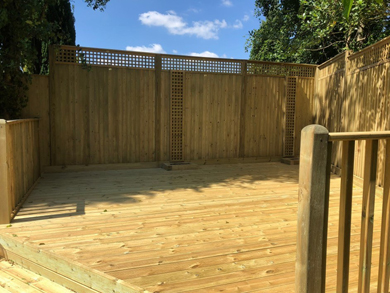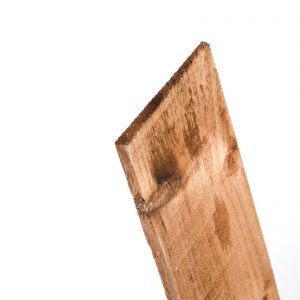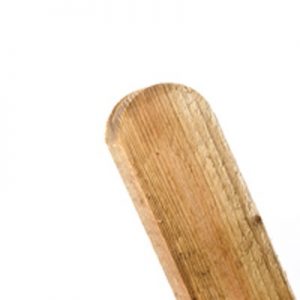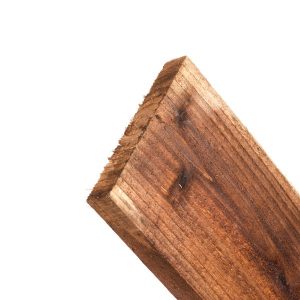Tanalised timber and pressure treated timber are actually exactly the same thing. They both refer to wood that has been specially treated with a mixture of chemicals to make the timber more durable and long lasting. This treatment is done under pressure which forces chemicals into the wood (thus “pressure treated” wood), and generally involves a chemical called Tanalith E (thus “tanalised” wood). Tanalith is a brand name of the chemical, the actual chemical used in the process may be a relation of Tanalith E, but one that gives the same final result.
Wood that has been tanalised or pressure treated will be more resistant to rot, fungus, mould, and insects, as well as hardier in extreme weather conditions.
How Long Does Tanalised Timber Last?
That’s difficult to say since a lot will depend on how timber is treated. A shed that’s on top of a windy hill in a very cold climate might not last as long as one in the sheltered corner of a garden. But circumstances aside, tanalising timber should mean that the wood is rot proof for a good number of years. In general, we say that the inside of the wood should be protected for about 60 years, and the outside for about 30 years. This is without any extra treatment, staining, or painting on your behalf. Again though, how you treat the wood is going to have an effect on how long it will last.
How Do I Treat Tanalised Wood?
You do not have to treat tanalised wood, though it is recommended for a couple of reasons. Firstly, your timber will last longer if you choose to do some maintenance. Secondly, tanalised or pressure treated wood tends to change colour over time. If you wish to avoid wood turning grey as it ages, then treating it will help.
It’s recommended that you treat your timber with a tanalised timber treatment that you can buy at most DIY stores. This treatment simply paints on over the wood and is simple to use. For the first year of ownership, you shouldn’t need to do anything. After that, an annual coat of treatment will keep your timber looking good and mean that you get much more wear out of it.
Can I Paint Tanalised Wood?
Absolutely! Painting tanalised wood not only makes your garden look great but also gives the timber an added layer of protection, which can only be a good thing. However, you do need to be careful when painting pressure treated timber.
You cannot paint freshly tanalised wood, since moisture in the timber will mean that the paint won’t stick properly. You will need to buy some pressure treated wood preservative and paint that on to seal the wood first. These preservatives do vary, so make sure to read the instructions. These instructions should tell you when it is appropriate to paint on the preservative, how many coats you need, and how long you need to wait before applying paint.
How Can I Tell if Wood is Treated?
There are a few ways to tell if the wood has been pressure treated. Firstly, the wood should be clearly marked as treated with a stamp. This is sometimes cut off when timber is cut down to size though. Secondly, treated wood that’s relatively fresh should have a green tinge to it This green colour fades over time down to a honey gold, and then a silver grey. But any timber you’re buying that has a green tint to it has been treated.
How Soon Can You Stain Pressure Treated Wood?
There is a lot of debate about how long you should wait before staining pressure treated wood. In general, you’ll need to wait for the tanalith to oxidise and the wood to dry out. This means waiting for at least three days of dry weather (if timber is outside) to allow moisture to escape before painting stain on. There’s an easy test to see if your wood is dry enough to paint. Spill a little water on the surface. If that water soaks in you can go ahead and paint, if it beads on the surface you’ll need to wait longer.
There are exceptions to this rule though. If your timber has been kiln dried after being pressure treated you can stain it immediately (kiln dried wood should be clearly marked as such and will be more expensive than regular treated timber). If you’re looking to paint, then it’s really recommended that you wait for around six months without any other treatment, or that you follow the manufacturer’s instructions when using a treated wood preservative.
How is Pressure Treated Wood Made?
The process of making pressure treated wood is quite a simple one. Firstly, wood is placed in a large tank that is sealed to create a vacuum. The treatment chemicals are then pumped into the tank, and since there is a vacuum these chemicals are forced into the wood to a depth of a few millimetres. The timber is then left to dry.
The chemicals used in the process mostly consist of copper, which provides excellent protection against insects and rot. Any other chemical involved is a “biocide” which means that it kills naturally occurring things, in this case, kinds of rot that copper doesn’t prevent against. All the chemicals used in the process are safe and can be used around both children and animals without worry.
What Type of Paint Should I Use on Pressure Treated Wood?
For best results, you should use a primer before painting. Look for a primer that’s for exterior use and that specifically states on the can that it can be used on pressure treated wood. Once the primer is dry you can technically use any kind of exterior paint that you’d like. Again though, for best results, we’d recommend a latex based paint. Oil-based paints do sometimes have trouble sticking to pressure treated wood, and a latex based paint job will simply last longer.
Does Pressure Treated Wood Need Painting/Staining?
No, not at all. You can safely leave your timber outside without any further treatment should you wish to. However, your timber will last longer if you choose to apply preservatives, treatments, stains and paint. And don’t forget, that wood is going to change colour over time without further intervention. Pressure treated wood is initially green, but this will fade to honey blond, and then a silvery grey colour. If you wish to stop this colour change process, painting or staining your wood is essential.






